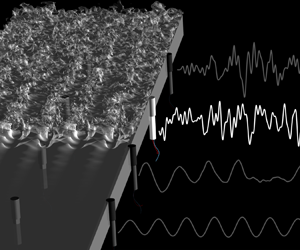Crossref Citations
This article has been cited by the following publications. This list is generated based on data provided by
Crossref.
Mons, Vincent
Du, Yifan
and
Zaki, Tamer A.
2021.
Ensemble-variational assimilation of statistical data in large-eddy simulation.
Physical Review Fluids,
Vol. 6,
Issue. 10,
Mao, Zhiping
Lu, Lu
Marxen, Olaf
Zaki, Tamer A.
and
Karniadakis, George Em
2021.
DeepM&Mnet for hypersonics: Predicting the coupled flow and finite-rate chemistry behind a normal shock using neural-network approximation of operators.
Journal of Computational Physics,
Vol. 447,
Issue. ,
p.
110698.
Zaki, Tamer A.
and
Wang, Mengze
2021.
From limited observations to the state of turbulence: Fundamental difficulties of flow reconstruction.
Physical Review Fluids,
Vol. 6,
Issue. 10,
Wang, Mengze
and
Zaki, Tamer A.
2022.
Synchronization of turbulence in channel flow.
Journal of Fluid Mechanics,
Vol. 943,
Issue. ,
Wang, Qi
Wang, Mengze
and
Zaki, Tamer A.
2022.
What is observable from wall data in turbulent channel flow?.
Journal of Fluid Mechanics,
Vol. 941,
Issue. ,
Buchta, David A.
Laurence, Stuart J.
and
Zaki, Tamer A.
2022.
Assimilation of wall-pressure measurements in high-speed flow over a cone.
Journal of Fluid Mechanics,
Vol. 947,
Issue. ,
Clark Di Leoni, Patricio
Agarwal, Karuna
Zaki, Tamer A.
Meneveau, Charles
and
Katz, Joseph
2023.
Reconstructing turbulent velocity and pressure fields from under-resolved noisy particle tracks using physics-informed neural networks.
Experiments in Fluids,
Vol. 64,
Issue. 5,
Clark Di Leoni, Patricio
Lu, Lu
Meneveau, Charles
Karniadakis, George Em
and
Zaki, Tamer A.
2023.
Neural operator prediction of linear instability waves in high-speed boundary layers.
Journal of Computational Physics,
Vol. 474,
Issue. ,
p.
111793.
Li, Sen
He, Chuangxin
and
Liu, Yingzheng
2023.
Unsteady flow enhancement on an airfoil using sliding window weak-constraint four-dimensional variational data assimilation.
Physics of Fluids,
Vol. 35,
Issue. 6,
Hao, Yue
Clark Di Leoni, Patricio
Marxen, Olaf
Meneveau, Charles
Karniadakis, George Em
and
Zaki, Tamer A.
2023.
Instability-wave prediction in hypersonic boundary layers with physics-informed neural operators.
Journal of Computational Science,
Vol. 73,
Issue. ,
p.
102120.
Jahanbakhshi, Reza
and
Zaki, Tamer A.
2023.
Optimal two-dimensional roughness for transition delay in high-speed boundary layer.
Journal of Fluid Mechanics,
Vol. 968,
Issue. ,
Du, Yifan
Wang, Mengze
and
Zaki, Tamer A.
2023.
State estimation in minimal turbulent channel flow: A comparative study of 4DVar and PINN.
International Journal of Heat and Fluid Flow,
Vol. 99,
Issue. ,
p.
109073.
Barthel Sorensen, Benedikt
Charalampopoulos, A.
Zhang, S.
Harrop, B. E.
Leung, L. R.
and
Sapsis, T. P.
2024.
A Non‐Intrusive Machine Learning Framework for Debiasing Long‐Time Coarse Resolution Climate Simulations and Quantifying Rare Events Statistics.
Journal of Advances in Modeling Earth Systems,
Vol. 16,
Issue. 3,
Morra, Pierluigi
Meneveau, Charles
and
Zaki, Tamer A.
2024.
ML for fast assimilation of wall-pressure measurements from hypersonic flow over a cone.
Scientific Reports,
Vol. 14,
Issue. 1,
Hao, Yue
Meneveau, Charles
and
Zaki, Tamer A.
2025.
Assimilation of wall-pressure measurements in high-speed boundary layers using a Bayesian optimization with DeepONet.
Physical Review Fluids,
Vol. 10,
Issue. 9,
Wang, Mengze
and
Zaki, Tamer A.
2025.
Variational data assimilation in wall turbulence: from outer observations to wall stress and pressure.
Journal of Fluid Mechanics,
Vol. 1008,
Issue. ,
Wang, Qi
and
Zaki, Tamer A.
2025.
Domain of dependence for wall-pressure measurements in high-speed boundary layers.
Journal of Fluid Mechanics,
Vol. 1009,
Issue. ,
Zaki, Tamer A.
2025.
Turbulence from an Observer Perspective.
Annual Review of Fluid Mechanics
,
Vol. 57,
Issue. 1,
p.
311.
Zaki, Tamer A.
and
Wang, Mengze
2025.
Data Driven Analysis and Modeling of Turbulent Flows.
p.
129.
He, Chuangxin
Li, Sen
and
Liu, Yingzheng
2025.
Data assimilation: new impetus in experimental fluid dynamics.
Experiments in Fluids,
Vol. 66,
Issue. 5,



